 |
|

|
 |
TABLE of CONTENTS
|
Four projects receive more than $400 million in Corridors of Commerce funding |
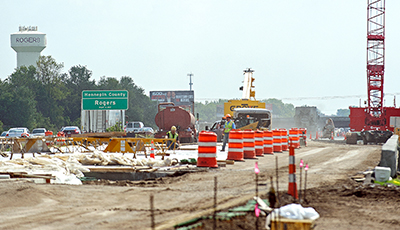
This Corridors of Commerce project on Interstate 94 between Rogers and St. Michael was completed in 2015. MnDOT announced May 2 that it would provide $417 million in funding for another four projects in the program. Photo by David Gonzalez |
MnDOT announced at a news conference May 1 that it was awarding a total of $417 million to four projects as part of the Corridors of Commerce program. The projects, intended to improve the state transportation system in ways that specifically support Minnesota’s economy, will begin during the next four years.
“Since 2013, the Corridors of Commerce program has funded projects that are important to the health of our transportation system and business climate, but not afforded in our four-year transportation investment plan,” said Commissioner Charlie Zelle. “The selected projects will enhance the movement of freight and people in the regions where these projects are located, which will aid the economy and reduce congestion.”
The four projects receiving Corridors of Commerce funding in 2018 are:
- Hwy 169 in Elk River (Greater Minnesota) – estimate up to $157 million. This project will convert Hwy 169 in Elk River to a freeway. The proposed project will construct interchanges at Main Street and School Street, 193rd Avenue, and a partial interchange at 197th Avenue. Project submitted by Justin Femrite, Elk River city engineer.
- Interstate 494, France Avenue to Hwy 77 (Metro District) – estimate up to $134 million. This project will construct a MnPASS lane on I-494 from France Avenue to Hwy 77 in the eastbound direction and a MnPASS lane from Hwy 77 to I-35W in the westbound direction. The proposed project is intended to improve the capacity of the interstate and dramatically improve the reliability of the average rush hour trip. Project submitted by Tony Fischer, Metropolitan Council.
- I-494, Bush Lake Road to I-35W (Metro District) – estimate up to $70 million. This project will construct the first phase of a turbine interchange that includes a directional ramp for northbound I-35W to westbound I-494 traffic. The proposed project is intended to improve interstate capacity and reduce crashes. Project submitted by Karl Keel, city of Bloomington public works director.
- I-94, St. Michael to Albertville (Greater Minnesota) – estimate up to $56 million. This project will expand I-94 from four to six lanes between Hwy 241 in St. Michael and County Road 19 in Albertville. The proposed project is intended to improve the capacity of the interstate by adding a third lane in each direction and make interchange improvements at Hwy 241 and at county roads 37 and 19 in Albertville. Project submitted by several people including Steve Bot (St. Michael city engineer), Adam Flaherty (Otsego city administrator), and Adam Nafstad (Albertville city administrator).
In January, MnDOT solicited project recommendations from the public, including local units of government, transportation advocates and interested citizens. It also conducted significant public outreach when developing the scoring criteria. MnDOT received a total of 299 project recommendations. After duplicate work and ineligible projects were removed, the agency had 172 project recommendations valued at $5.5 billion.
With the assistance of a consultant engineering firm, the agency scored and ranked the recommended projects using a set of eligibility and selection criteria, which were passed by the Minnesota Legislature and required under state law. Criteria included the proposed project’s return on investment, economic impact, freight efficiency, safety improvement, regional connections, policy objectives and community consensus. The final key requirement was that 50 percent of the funding be spent in Greater Minnesota, or those MnDOT areas that are not in the MnDOT Metro District, and 50 percent be spent in the Metro District, which is the seven-county metro area plus Chisago County.
“It is important to note that we followed direction set by the Minnesota Legislature regarding the solicitation, scoring criteria and geographic distribution of funding,” Zelle said. “We brought the scoring criteria to the public to get input prior to the solicitation. And, MnDOT did not put any projects in that solicitation.”
Governor Dayton and the Minnesota Legislature created the Corridors of Commerce program in 2013 to invest in projects that support commerce in the state, but that are not already considered in the state’s transportation investment plan. Since that time, the program has provided more than $330 million to dozens of projects across the state. For more information about the program, and to view the submitted project recommendations, visit www.mndot.gov/corridorsofcommerce. |
 |
|

|
 |
TABLE of CONTENTS
 |
City, county, state officials break ground on Glenwood Complete Streets project |
By Judy Jacobs
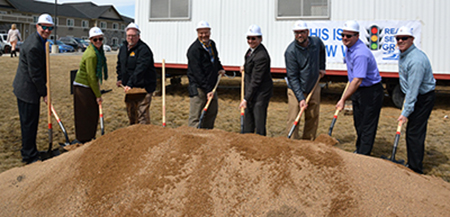
MnDOT officials attended the recent Complete Streets groundbreaking in Glenwood. From left to right, Eric Davis, Chief of Staff; Tori Nill, District 4 acting district engineer; Mark Welling, District 4 project inspector; Dan Kuhn, District 4 resident engineer; Commissioner Charlie Zelle; Brad Cegla, District 4 construction project manager; Shiloh Wahl, District 4 assistant district engineer program development manager; Tom Pace, District 4 project manager. Photo by Judy Jacobs |
After nearly a decade of discussions and planning, officials and residents from the city of Glenwood, Pope County and MnDOT got together April 20 to break ground on a project that will completely change the appearance of Glenwood’s downtown area.
The city, county and MnDOT are partnering on a resurfacing project to address pavement concerns, accessibility issues, traffic flow, utility needs and boulevard improvements.
In addition to this work, six blocks of downtown will be reconstructed using the Complete Streets concept that includes wider sidewalks, a bike lane, an amenity zone with seating and plantings, new traffic lights and new street lighting.
Mayor Scott A. Formo, Sr., talked about the Glenwood contingent meeting with Commissioner Charlie Zelle three years ago to help get the project back on track after a decision to put the project on hold.
“We drove to St. Paul to meet with Commissioner Zelle personally,” said Formo. “We had a vision for Glenwood’s downtown area and this project will allow us to realize it.”
Approximately 70 local residents and officials attended a luncheon with Commissioner Zelle prior to the groundbreaking. More than 100 people were at the groundbreaking.
“For me personally, it was rewarding to attend the groundbreaking and see the positive interactions between the partners on this project,” said Dan Kuhn, District 4 resident engineer for the project. “The city of Glenwood, Pope County commissioners, Grow Glenwood and the Glenwood Chamber representatives have an optimism that is contagious and will serve them well throughout the project.”
Work will be conducted in five stages. The project is scheduled to be competed by late October, 2018. |
 |
|

|
 |
TABLE of CONTENTS
 |
MnDOT remembers fallen workers at Worker Memorial Day observances |
|
By Sue Roe
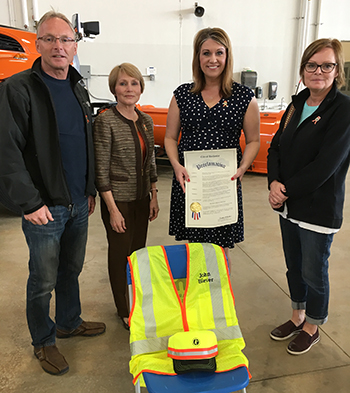
Family members of John Biever, whose name was added to the Worker Memorial list this year, attended the District 6 Worker Memorial Day event. From left are John Biever, who is John Biever's grandson, and Dr. Dawn Lowery, granddaughter, Anne Meyer, District 6 PAC, and Lisa Glomski, granddaughter. Meyer is holding the Rochester Mayor's Worker Memorial Day proclamation. Photo by Mike Dougherty |
Three districts and Central Office observed Worker Memorial Day this year. The annual event honors the 35 MnDOT workers and 15 contractors who died since 1960 while working on Minnesota highways.
Gov. Mark Dayton proclaimed April 28 as Worker Memorial Day and the Interstate 35W bridge in Minneapolis was lit orange April 28-30.
This year, District 6 added a new name to the Worker Memorial list. John Biever, 54, was hit by a pickup truck and killed in 1962 while working on a bridge in Houston County, but his name never got added to the Worker Memorial list when it was created.
Anne Meyer, District 6 public affairs coordinator, found information about the crash from a story in the Minnesota Highway Department newsletter. She contacted Biever’s family, who consented to his name being added to the list and the Worker Memorial at Central Office in St. Paul.
Dr. Dawn Lowery, Biever’s granddaughter, was among his family members who attended the Worker Memorial Day observation in Rochester Thursday, April 26. She spoke during the event, recalling stories of her grandfather. She encouraged motorists to do their part during the construction season to keep workers safe.
Other speakers included Jeff Vlaminck, District 6 engineer; Sue Mulvihill, deputy commissioner; Brittany Anderson, Southeast Minnesota Area Labor Council; Sgt. Troy Christianson, Minnesota State Patrol, and Rochester Mayor Ardell Brede.
In District 7, the event was hosted by AFSCME Local 280 at the Mankato headquarters April 30. About 125 people attended. Mike Hanley, transportation generalist, spoke about his experience when the MnDOT vehicle he was in was hit by a minivan. Hanley was protecting a crew repairing a guardrail when his vehicle was hit.
A poem written by Dale Plemmons, former MnDOT safety administrator, was read before the reading of the names on the chairs and a moment of silence.
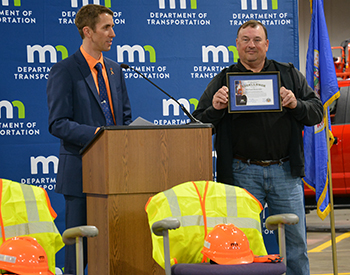
Bryan Dodds, left, Office of Operations and Maintenance director, introduces Michael Bolander, Golden Valley Truck Station, who received the 2018 Metro District Work Zone Safety award for his contributions to outstanding work zone safety. Photo by Sue Roe |
Families of Mike Struck, District 7 employee who died on the job in 2011, and Darrell Blackwell, District 7 employee who died on the job in 2006, were in attendance.
At the Metro District event at the Maryland Truck Station April 30, speakers were Scott McBride, district engineer; Michael Beer, construction engineer; Lt. Jeff Schroepfer, Minnesota State Patrol; and Bryan Dodds, director, Office of Operations and Maintenance.
“We honor the memory of our fallen co-workers by sharing our commitment to safety in our workplace,” said McBride. “We’ll work for the safety of MnDOT employees, our contractors, the driving public and all of our transportation partners.”
Dodds presented a Metro District work zone safety award to Michael Bolander, Golden Valley survey chief, for his contributions to work zone safety.
“Michael’s dedication to safety means that he does not take any shortcuts on the job and always stresses getting the job done in an efficient and safe manner,” said co-worker Brett Fischer in his nomination for Bolander. “He follows MnDOT safety policies and emphasizes job safety throughout the entire day for both himself and his coworkers.”
Several pieces of construction safety equipment were displayed at the event.
At Central Office, an empty chair, vest and hardhat were displayed on each floor April 30. A recorded audio message was broadcast over the loud speaker from Mulvihill. The message included 10 seconds of silence to remember the transportation workers who gave their lives while working to build and improve the transportation system.
“Over the years, we have said good-bye to too many co-workers and friends who were killed in Minnesota work zones. We must work harder than ever to ensure that no one else is killed or seriously injured in a work zone,” she said.
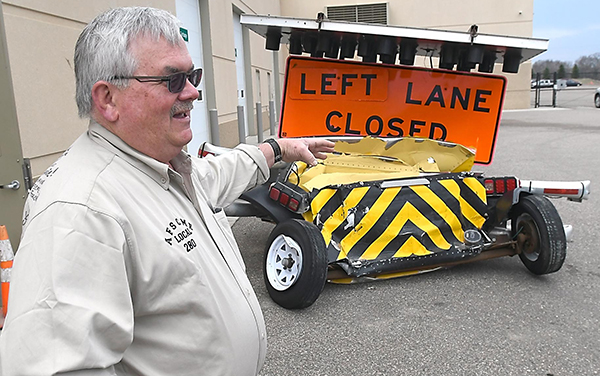
Mike Hanley, District 7 transportation generalist, stands near the safety trailer that was behind his truck when he was hit by a minivan on Hwy 169 near Mankato. Hanley was protecting a crew repairing guardrail. Hanley spoke during District 7's Worker Memorial Day observance. Photo courtesy of the Mankato Free Press |
|
 |
|

|
 |
TABLE of CONTENTS
 |
MnDOT implements employee emergency alert mass notification system |
By Rich Kemp
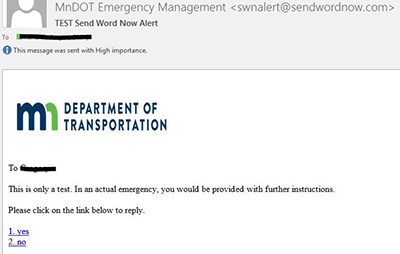
This is how an alert will look when an employee receives a message from Send Word Now. |
Send Word Now is the mass notification system used by MnDOT’s Office of Emergency Management to support emergency preparedness and continuity of operations planning.
The system allows MnDOT to reach its employees quickly and efficiently using multiple points of contact, including phone calls, email and text messages. It aids MnDOT's capability to communicate in a crisis and helps determine if an employee needs assistance.
No one method of communication can reach everyone, everywhere and every time. Redundancy through numerous and various communication methods is offered by Send Word Now.
“Communication is key in any type of emergency event or business interruption,” said Carol Magurany-Brotski, Office of Emergency Management planner. “An emergency event can be small and local or have a widespread impact. Events that impact MnDOT’s employees and operations can be utility, weather, technological or manmade related.”
“Having a mass notification system to send an emergency alert message answering who, what, when, where and why in a timely manner including after work hours and weekends is a very valuable tool.”
When MnDOT’s Emergency Management or Communications Office becomes aware of an emergency event or other type of business interruption, even if outside of working hours, employees may receive a message from Send Word Now. An emergency event may be a fire, flood or utility outage that could impact safe working conditions.
An alert message will inform employees of what actions, if any, they should take for the present situation. It will also inform employees of any updates about the emergency as new information comes available.
Send Word Now has the capability for one- or two-way messaging, which means that in some circumstances employees may reply back with a selected response.
As a state agency, MnDOT is responsible for carrying out essential state functions such as general emergency preparedness, planning, response, recovery, hazard mitigation, continuity of operations and priority service continuation responsibilities. This requires the ability to contact MnDOT employees in the event of a workplace emergency or other disruption that would have a public safety/public health impact or a disruption to MnDOT priority services. Minnesota Statutes, section 13.43, subdivision 17Subd., Continuity of operations allows government employers to obtain contact information, this includes personal home contact information to ensure that an employee can be reached in the event of an emergency affecting continuity of operation of a government entity.
Providing a mass notification alert service is Send Word Now's only purpose. Send Word Now pulls contact information from the State of Minnesota Employee Self-Service/SEMA 4 database. The contact information would only be accessed by MnDOT designees who are authorized to send out emergency management communications.
“It is important that we test and exercise the Send Word Now system,” said Magurany-Brotski. “In the future, MnDOT Emergency Management will send out an Outlook email to specific groups, offices or buildings occupants, informing them of an upcoming Send Word Now test. The test is one way of making sure we are making connections and for employees to recognize how the Send Word Now message looks. The goal is to make the message look familiar so employees are not afraid to open the message.”
As with actual alerts, test alerts will be sent via any or all of the notification methods simultaneously (email, voice/phone and text).
Employees should log into Self-Service to review and update your contact information. Update the information for phone numbers, email addresses, mail and emergency contact.
Refer to the Send Word Now website http://ihub/emergency-management/send-word-now-verify.html that walks you through how and what contact information should be updated in SEMA 4. |
 |
|

|
 |
TABLE of CONTENTS
 |
District 3 holds Employee Day at Camp Ripley |
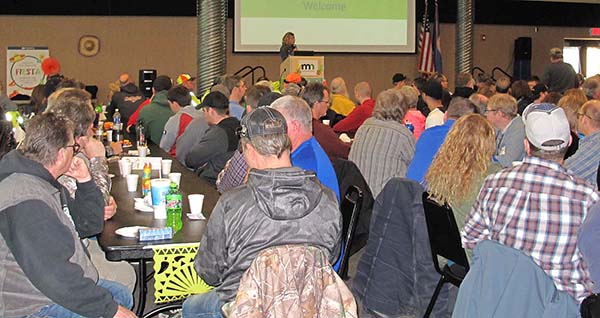
More than 360 employees attended "District 3 is the Place to Be" Fiesta employee day at Camp Ripley April 17. (above) Cindy Gross, Operations Division business manager, spoke to the employees during the event. Dr. Richard Gasaway, the keynote speaker, talked to the group about situational awareness. Other breakout highlights included tours of the Camp Ripley Equipment Maintenance Facility and the Environmental Center, and Joe McKinnon, District 2, spoke about the Hwy 72 bridge replacement in Baudette. (below) Mary Schilling, plan development; Betty Jo Winterowd, administrative manager/employee day co-chair; and Luke Wehseler, project manager, chat during a break. District 3 holds the employee day every two years and is organized by employees for employees. Photos by Jenny Seelen
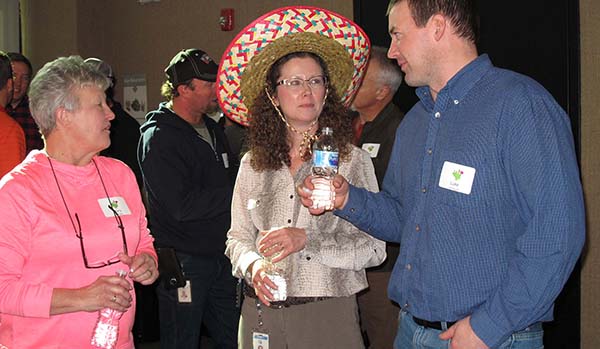
|
|
 |
|

|
 |
TABLE of CONTENTS
 |
Real-time winter weather alerts planned for highway message signs |
By Shannon Fiecke, Research Services & Library
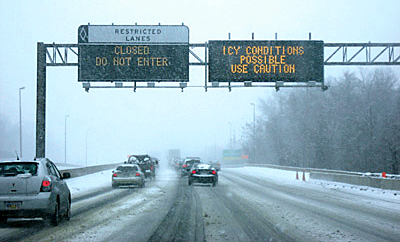
Winter weather advisories, similar to the one shown here, will be possible following an upgrade to Minnesota's Dynamic Message Signs system. Photo courtesy of the Federal Highway Administration |
The longest winter in recent memory might have ended, but MnDOT’s traffic and maintenance staff are already planning how to make future winters easier on Minnesota drivers.
Last month, the Regional Transportation Management Center was awarded funding to deliver real-time winter weather warnings via its roadside and overhead highway message signs. The RTMC displayed blizzard warnings for the first time during six storms last winter, but the alerts had to be manually entered.
“This is similar information that you receive on your cell phone or the evening news,” said Brian Kary, RTMC Traffic Operations director. “But for somebody who's traveling down I-90 and just passing through, they might not realize that they're entering an area with a blizzard.”
Another initiative aims to expand the road condition data that’s available during winter storms by piloting the use of mobile sensors on maintenance supervisor trucks and above-ground sensors at select Road and Weather Information System sites.
Both projects are among eight research implementation projects recently selected for funding by the governing board for MnDOT’s transportation research program.
Weather alerts
Minnesota has nearly 300 Dynamic Message Signs, which currently issue real-time warnings about traffic incidents, road work and congestion. Around 200 are in the Twin Cities metro; the rest are in Greater Minnesota.
Kary’s two-year project will develop a system that can automatically relay critical weather alerts, which change frequently, are labor-intensive and error-prone when physically entered. Only blizzard warnings from the National Weather Service are initially planned, but the system will be capable of broadcasting all types of weather alerts.
A number of other states already issue weather alerts via their Dynamic Message Signs, so MnDOT has case studies to look at.
It’s possible that the signs could also someday relay information from MnDOT’s Maintenance Decision Support System and roadside weather sensors. A current pilot project uses weather sensors and flashings on a rural stretch of highway near Dassel Cokato High School to warn motorists and notify maintenance staff of unexpected blow ice.
Improving road condition information
Over the next two years, the Maintenance Office will test the use of mobile and above-ground sensors to expand the geographic coverage of RWIS sites, which feed valuable weather and road surface information to highway operations managers and advanced traveler information systems. This might lead to the elimination of in-road sensors, which require lane closures to maintain and must be replaced during road construction projects.
The mobile sensors will collect road condition information, such as temperature, humidity, due point, and friction, from five maintenance supervisor trucks. The other non-invasive sensors will be attached to an RWIS tower or a pole near the roadway and use laser technology to read road surface temperature and condition (water ice, slush and snow). |
 |
|

|
 |
TABLE of CONTENTS
 |
State survey results show MnDOT has strong customer focus |
|
MnDOT has made a positive shift in focus on customers according to the latest results of the statewide Continuous Improvement Survey employees responded to in fall 2017.
“Employees’ work and commitment to WIG 2.0, Earning Customer Trust, likely factored into these results,” said Suzie Thayer, Office of Administration director.
This was the second time all executive branch agencies participated in the survey, part of Gov. Mark Dayton’s Better Government for a Better Minnesota initiative. The survey considers factors that can influence an organization’s culture of improvement and provides agency leaders with data to:
- Identify the readiness for change in each agency
- Pinpoint where to focus to increase a culture of improvement
- Track continuous improvement culture change over time
MnDOT had 1,461 employees (30 percent) who responded to the 2017 survey, a response rate similar to the baseline survey in 2015. Thayer said that MnDOT would work to increase participation in the 2019 survey “to ensure that all voices are heard.”
The survey asked employees to consider 13 statements and mark their level of agreement with each one. Below are some survey highlights indicating the percent of MnDOT respondents who "agreed or strongly agreed" with each of these statements:
- I believe that my agency’s culture supports ongoing improvement to our work and services (new question in the 2017 survey) – 76.11 percent
- I know who my work serves within or outside of my agency (new question) – 96.99 percent
- My agency uses feedback from people we serve to improve our programs and services – 72.28 percent, up from 61.85 percent in 2015. The survey analysis notes: “This increase is a strong indication that over the last two years MnDOT has taken action to collect customer feedback, and communicate more with employees about the importance of engaging customers.”
- I know how my work contributes to my agency’s mission – 95.69 percent, up slightly from 2015.
- In the last 12 months I have had the opportunity to improve how my group or agency works – 77 percent, up from 63 percent in 2015. The survey analysis notes: “Opportunities to participate in improvement work increases the efficiency and effectiveness for the particular improvement efforts these employees work on. This has the multiplier effect of building a culture where staff feel confident that they will have the opportunity to fix things that are not working. Actions MnDOT has taken to encourage and support participation in improvement efforts have paid off and should continue!”
- I know how my team or workgroup measures our performance – 78.58 percent, up from 39.52 percent in 2015.
- I know how my division measures our performance – 65.37 percent, up from 37.57 percent in 2015.
The report provided several recommendations for how MnDOT leaders can use the results, including using customer feedback to drive improvement efforts.
The full survey report is available at MnDOT Continuous Improvement Survey Results 2015-2017. Contact Dave Pehoski, 651-366-3072, for more information. |
 |
|

|
 |
TABLE of CONTENTS
 |
2017 sustainability report highlights strategies to meet ambitious goals |
By Siri Simons, Office of Environmental Stewardship

Energy efficiency and renewable energy can help MnDOT achieve its energy reduction goals. In District 6, a 40 kW solar panel array helps power MnDOT's Rochester Headquarters. Photo by Mike Dougherty |
The state’s transportation system was designed to withstand historic weather and climate, but the climate is changing and historic conditions no longer reliably predict future risk. MnDOT has a responsibility to reduce its impacts on climate change and make transportation infrastructure resilient to changes in climate.
MnDOT updates annual Sustainability Report
In 2016, MnDOT launched the first agency sustainability report that created ambitious sustainability goals and established a baseline MnDOT will use to track progress over time. The 2017 Sustainability Report is the first annual update and describes strategies that are used to meet the goals established in 2016.
“The report focuses on internal agency operations and also includes goals for reducing greenhouse gas emissions from the broader transportation sector,” said Tim Sexton, Office of Environment Stewardship section director. “While MnDOT only manages about 10 percent of all Minnesota roadways, the agency has a larger influence in statewide policy and decision-making.”
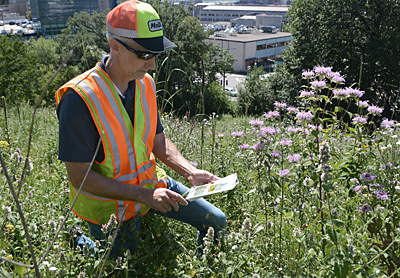
MnDOT aims to increase native plantings on larger MnDOT projects. Dave Hanson, vegetation management specialist, Office of Environmental Stewardship, uses MnDOT's noxious weed guide to identify weeds along a roadside. Photo by Sue Roe |
Sexton said the report identifies high-level strategies such as internal standards, process improvements, research and new technologies to reach MnDOT’s sustainability goals.
“Subject matter experts at MnDOT spent last year developing and refining these strategies and worked with the steering committee and management groups to get feedback and approval for the approach,” said Sexton.
Focus areas in the report include:
- Improve energy, waste and water efficiency in MnDOT buildings
- Use cleaner transportation options for the fleet
- Balance environmental protection with safety by reducing salt use
- Support pollinators with native plantings
- Use sustainable construction methods
Toward a sustainable transportation system
The sustainability report was developed by the MnDOT Sustainable Transportation Steering Committee. The STSC was formed in 2016 to provide leadership, strategic direction and oversight for agency sustainability efforts consistent with the MnDOT vision to maximize the health of people, the environment and the economy. Deputy Commissioner Sue Mulvihill champions the group and members include district and central office leadership, with functional expertise from across the agency.
MnDOT is a national leader in several areas related to sustainable transportation, including complete streets, sustainable pavements and electric vehicle promotion. The report continues to demonstrate leadership and provides opportunities for further action.
Strategy in the spotlight: MnDOT reduces energy use
Between 2016 and 2017, energy use from MnDOT buildings declined by 3 percent. This progress stems from an initiative MnDOT launched in 2011 to reduce energy use. MnDOT reduces energy use by cataloguing building energy use, identifying equipment with less than five years of useful life, assessing building automation systems, and implementing cost-effective energy efficiency and renewable energy measures, such as lighting and equipment upgrades.
In April 2018, building operating standards were established to reach MnDOT's energy and greenhouse gas emissions reduction goals. Fully implementing temperature set point standards will result in an estimated 6 percent to 10 percent reduction in overall MnDOT building energy consumption. The new standards are estimated to save MnDOT upwards of $200,000 annually, allowing MnDOT to use these savings to help fund other needed investments.
|
|
|
 |
|

|
|

|
 |
TABLE of CONTENTS
 |
What's new on the web |
Lunch and learn: Tribal Relations
Levi Brown, MnDOT’s new tribal liaison manager, talked about native culture, traditions and his vision for building better working relations between the tribes and state agencies. The presentation can be found on the Tribes and Transportation web page.
New Library Materials posted on the Web
New Library Materials are available at http://www.mndot.gov/library/newlibmat.html. This issue features a new library guide for setting up alerts for transportation publications.
New Library Materials is a compilation of new titles and other resources added to the library collection during the previous month(s). Previous editions of New Library Materials are archived and available at http://www.mndot.gov/library/recacq-archive.html. If you would like to be added to the distribution list or have any questions, please email MnDOT Library at library.dot@state.mn.us or send requests via the Ask a Librarian Web page (www.mndot.gov/library/asklibrarian.html). |
 |
|
| |
|



